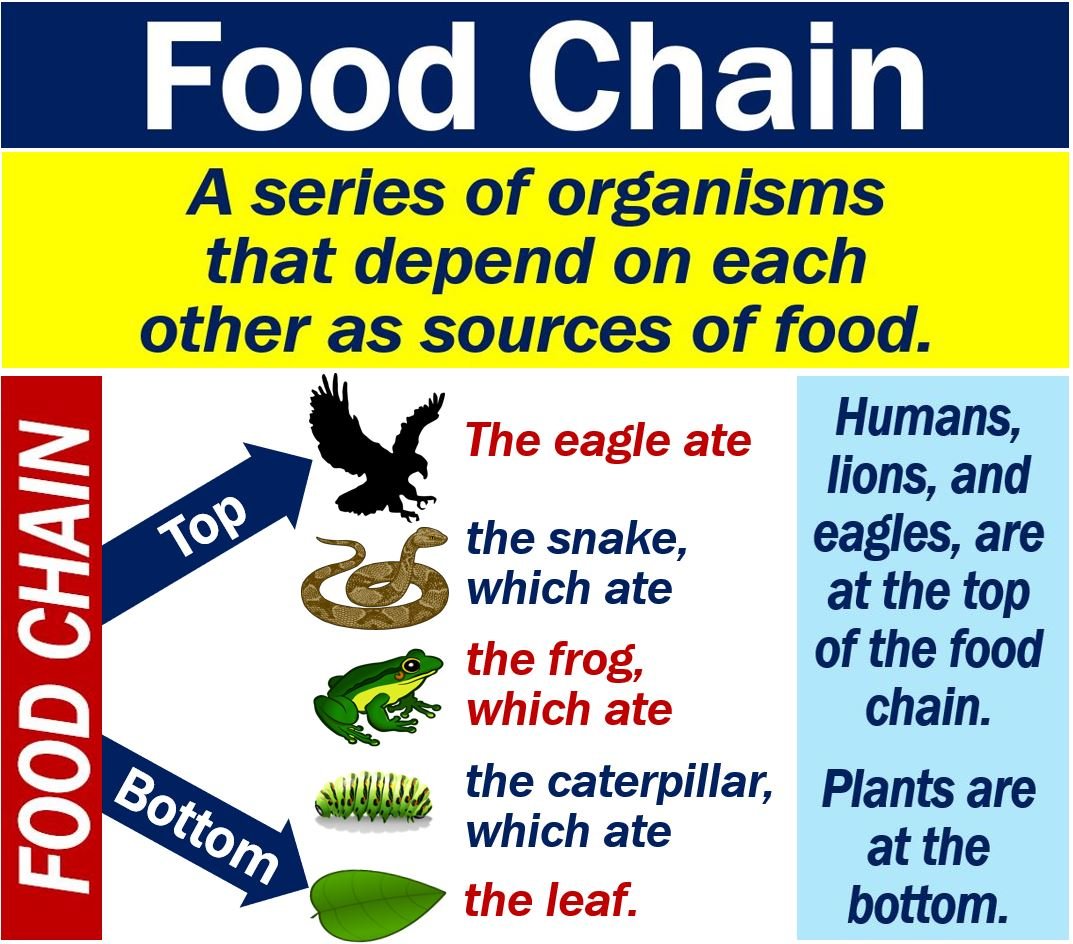The Food Chain is a series of living beings that depend on each other as a source of food. At the bottom of the food chain, the herbage, are the producers. All the other organisms above the producer are consumers.
In economics, the food chain is the series of processes by which we grow, sell, and eventually consume food.
This article focuses on the term when it refers to organisms that depend on each other as a source of food.
According to the Khan Academy:
“A food chain is a linear sequence of organisms through which nutrients and energy pass as one organism eats another.”
“In a food chain, each organism occupies a different trophic level, defined by how many energy transfers separate it from the basic input of the chain.”

Food chain – producers and consumers
Plants are at the bottom of the chain, i.e., that’s where it all starts. Plants get their energy from sunlight.
We call plants ‘producers’ because they produce their own food. They do not consume other living organisms.
Animals, including humans, on the other hand, are consumers. We do not make our own food, i.e., we consume it. Animals either eat plants, other animals, or both.
Humans, dogs, and pigs, for example, are omnivores. We eat both plants and other animals.
Animals that kill and eat other animals are predators. When people are fishing, they are predators. The fish are the prey. Prey refers to the animals that the predator hunts and eats.
Food chain example
A predator is higher up the chain than its prey. Whatever the prey eats is further down the chain.
Let’s imagine a pack of wolves, some sheep, and grass. The grass, i.e., the producer, is at the bottom. Slighter higher up than the grass are the sheep. The sheep eat grass.
The wolves do not eat the grass, but they eat the sheep. Therefore, the wolves are further up the chain than the sheep.
Nothing eats the wolves. Therefore, in that habitat, the top of the food chain consists of wolves.
Food chain – habitats
The bottom of the chain consists of plants. That never changes. However, which animal is on the top of the chain depends on the habitat.
For example, the lion is on the top of the food chain in the grasslands and savannas of Africa. No animal eats the lion, but the lion eats gazelles, zebras, and other herbivores.
However, in the African grasslands, vultures, hyenas, and cheetahs are also on the top. No animal eats hyenas, cheetahs, or vultures.
In North America, the grizzly bear and mountain lions are on top of the food chain.
Our oceans have many predators on top of the chain. The great white shark and killer whale, for example, are the kings of the ocean. In the Arctic Circle, it is the polar bear.
Each ecosystem’s intricate balance is maintained through these food chain dynamics, ensuring species diversity and ecological stability.
Food chain vs. food web
In biology and ecology, we use the terms food web and food chain. Their meanings are different.
Moving beyond linear interactions, food webs illustrate the vast network of predator and prey relationships in a more comprehensive ecological context.
Many food chains make up a food web. A chain follows just one path from a plant to, for example, an eagle.
The eagle ate the lizard, which ate the frog, which ate the caterpillar, which ate the leaf.
A food web shows the different paths in which producers, i.e., plants, and consumers, i.e., animals, are connected.
When talking about consumers in economics, we sometimes refer to a hierarchy as the food chain. In this context, ‘consumer’ refers to a person or organization that buys or hires goods and services.
Food chain – vocabulary and concepts
There are many terms in the English language that are linked to the “food chain” concept. Let’s have a look at some such compound phrases, their meanings, and how we use them in a sentence:
-
Food Chain Link
An individual step or position in the food chain, representing a specific feeding level in an ecosystem.
Example: “The frog is a crucial food chain link, preying on insects and providing food for birds.”
-
Food Chain Dynamics
The complex interactions and processes between different organisms in a food chain.
Example: “Scientists study food chain dynamics to understand the impact of species extinction on an ecosystem.”
-
Food Chain Position
The specific level or role an organism occupies in the food chain.
Example: “In its food chain position, the owl acts as a top predator, controlling the population of rodents.”
-
Food Chain Length
The number of steps between the primary producer and the top predator in a food chain.
Example: “A short food chain length often indicates a less complex ecosystem.”
-
Food Chain Impact
The effect that changes in one part of the food chain can have on the entire system.
Example: “The introduction of a new predator had a significant food chain impact, altering the local biodiversity.”
-
Food Chain Model
A simplified representation of the feeding relationships between organisms, used for educational or research purposes.
Example: “The classroom’s food chain model helped students visualize how energy flows from one organism to another.”
Video – What is the Food Chain?
This video, from our sister channel in YouTube – Marketing Business Network – explains what “Food Chains” are and the connection between living things:
